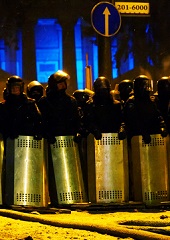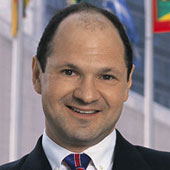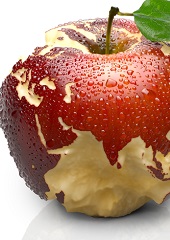Ukraine and Ireland: Overcoming Mighty Neighbors
What do Ukraine and Ireland have in common, in their struggles with Russia and the UK?
February 8, 2014

Hundreds of thousands all over Ukraine have taken to the streets to take democracy into their own hands. They are protesting the corrupt rule of their thuggish president, Viktor Yanukovich. But their ultimate goal is to bring their country into the United Europe — and out of the grasp of its giant eastern neighbor.
On the alphabetical list of countries, Ukraine sits right next to the UK. Historically and culturally, though, it is far closer to Britain’s neighbor and long-time colony, Ireland.
Ireland is situated on the northeastern periphery of Europe, at the edge of the known world — as seen by the mainland Europeans until Columbus’s 1492 voyage.
The name of Ukraine, meanwhile, is derived from a Slavic word meaning “borderline” or “periphery.” Furthermore, in the Russian Empire, Ukraine was known as Malorossia, or “Little Russia.” No surprise, then, that the Romans called the smaller of the two large British Isles (today’s Ireland) Micra Britannia, or “Little Britain.”
Ukraine is huge in terms of territory (it’s the second-largest country in Europe). However, in relative terms, compared to the major power next door, it is “smaller” than Ireland.
The British Isles had been inhabited by Celtic tribes until, in the late Roman period, Anglo-Saxons began settling there.
The nexus between Russia and Ukraine is even closer. The Russian state officially claims its origins from Kiev, the capital of Ukraine. And Moscow was founded by a Kievan prince.
Both England and the Duchy of Muskovy grew strong over time, first fighting to repel or expel foreign invaders and then turning their attention to smaller and weaker neighbors.
England’s control over Ireland was established at the turn of the 17th century, making it the first English colony. Ukraine fell under Russian rule 50 years later. Ireland gained independence in 1922, while Ukrainians had to wait nearly 70 years more, until the collapse of the Soviet Union.
Even though at different periods the Irish and the Ukrainians seemed to acquiesce to colonial rule, they fiercely clung to their identity and resisted assimilation. Both had their religion as a source of strength.
In Ireland, it was the Roman Catholic faith. In Ukraine, Greek Catholicism. The latter traces its origins to Kiev’s adoption of Christianity a thousand years ago. While Greek Catholics may be a distinct and often persecuted minority, their church always kindled the fires of Ukrainian nationalism. It did so not only in Russia, but also in neighboring Poland, Hungary and Romania.
The Brits are notoriously law-abiding. In contrast, the Russians have little respect for the rule of law. They are, however, docile and tolerate oppression by their rulers without complaint.
Not so the Irish or the Ukrainians. They have a true anarchic streak, which in Ireland manifests itself in the persistence of the Travellers groups. As to Ukraine, anarchism exploded during the Russian Civil War in the years 1917-22. Back then various nationalist and populist gangs roamed the country’s steppes and a full-fledged Anarchist movement, led by Nestor Makhno, gained tens of thousands of followers.
In the 19th century, nationalist pro-independence movements began to gather momentum in both Ireland and Ukraine. Given the power of their colonial masters, it looked like a hopeless task at first. That’s why both the Irish and the Ukrainians didn’t hesitate to advance their claims when London and Moscow found themselves in difficulties.
The Irish rose up in 1916, as Britain was being bled white by the Great War, and refused to join the global alliance against Hitler during World War II. The Ukrainians similarly tried to create their national state during the chaotic aftermath of World War I and after the German invasion in 1941.
The Brits did their best to transport the Irish to far-flung colonies or to make them emigrate. As a result, the Irish diaspora today is estimated at some 70 million, approximately 11 times larger than Ireland’s population.
Ukrainians were sent en masse to Siberia and the Russian Far East. Today, Ukrainian last names are far more common in these regions than Russian ones. The worldwide Ukrainian diaspora is smaller than the Irish one, but in Canada, for example, Ukrainians and their descendants number 1.2 million.
Famines as joint history
And then there were the famines. Ireland suffered the Great Famine when its potato crops failed between 1845 and 1852. As many as two million perished (or up to 25% of the population) and another million emigrated.
Ukraine, which before World War I was known as the breadbasket of Europe, was put through an even worse man-made genocide engineered by Stalin and his henchmen. Known in Ukrainian as Holodomor, its scale and senseless cruelty rivals those of the Holocaust. During the 1932-33 collectivization drive, as many as 10 million Ukrainians were starved to death out of a population of 40 million – the same terrible 25% as in Ireland.
Free at last
Both countries are now free and have national governments, but they are not yet rid of the shadow of their former colonial masters — not least because of lingering territorial issues.
The Irish, for their part, regard Northern Ireland as an artificially created majority-Protestant enclave occupied by Britain. Meanwhile, the Russians decry the fact that the Crimea, with its majority Russian population, was arbitrarily transferred to Ukraine in 1954. Ukraine’s Eastern industrial heartland, which is President Yanukovich’s power base, has a large ethnic Russian population and gravitates toward Russia.
Finally, both countries have cherished their own language. Once the sole purview of linguistic and literary scholars, Irish is now used on a radio and television station. And even though most Ukrainians speak Russian well — almost as well as the Irish speak English — they have been able to preserve their own distinct language. It is widely spoken and there is a vast — and growing — body of literature written in Ukrainian.
The Irish have traditionally identified with the Poles and their struggle for freedom and for their own national state. They are obvious parallels between two Catholic nations being oppressed by – and constantly rebelling against – an overwhelming colonial power of a different confession.
But in fact, the Ireland-Ukraine pairing may be closer. As Ukrainians fight security forces on the barricades in Kiev and other Ukrainian cities, this history — and its parallels with Ireland — should be kept in mind.
Takeaways
In the Russian Empire, Ukraine was known as Malorossia, or “Little Russia.”
The Romans called today’s Ireland Micra Britannia, “Little Britain.”
Though the Irish and Ukrainians acquiesced to colonial rule, they fiercely clung to their identities.
Both countries had their religion as a source of strength.
In Ireland, it was the Roman Catholic faith. In Ukraine, Greek Catholicism.
The Irish and the Ukrainians have a true anarchic streak.
In the 19th century, nationalist pro-independence movements began to gather momentum in Ireland and Ukraine.
The Irish and Ukrainians advanced their claims when London and Moscow had difficulties.
The Irish rose up in 1916, as Britain was being bled white by the Great War.
The Ukrainians tried to create a national state after World War I and after the German invasion in 1941.
Ireland suffered the Great Famine when its potato crops failed between 1845 and 1852.
Ukraine was put through an even worse man-made genocide by starvation engineered by Stalin.

